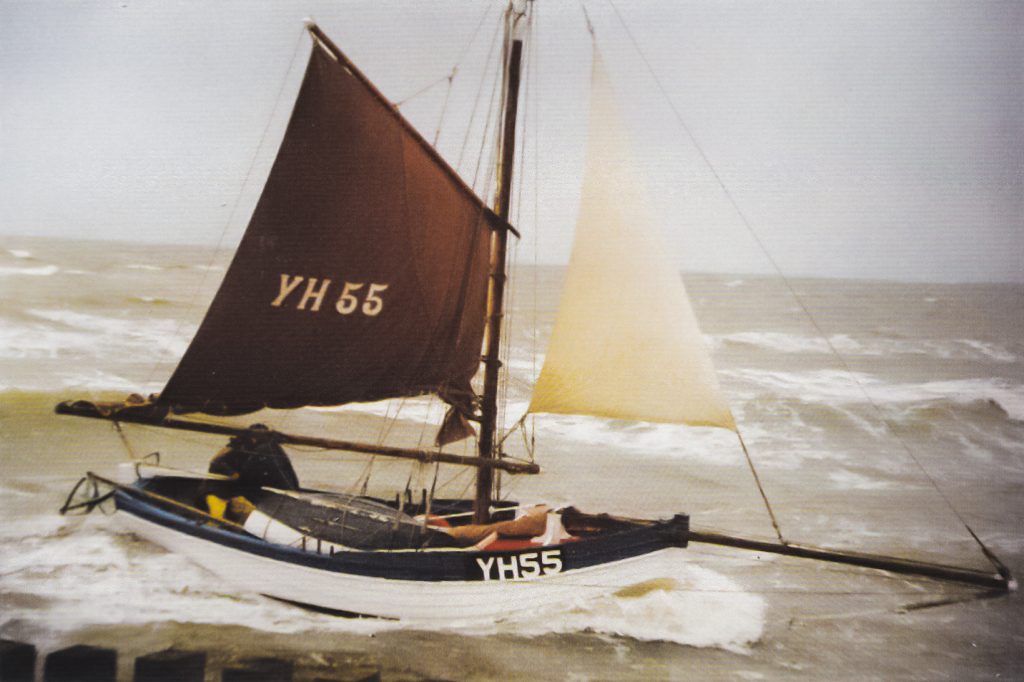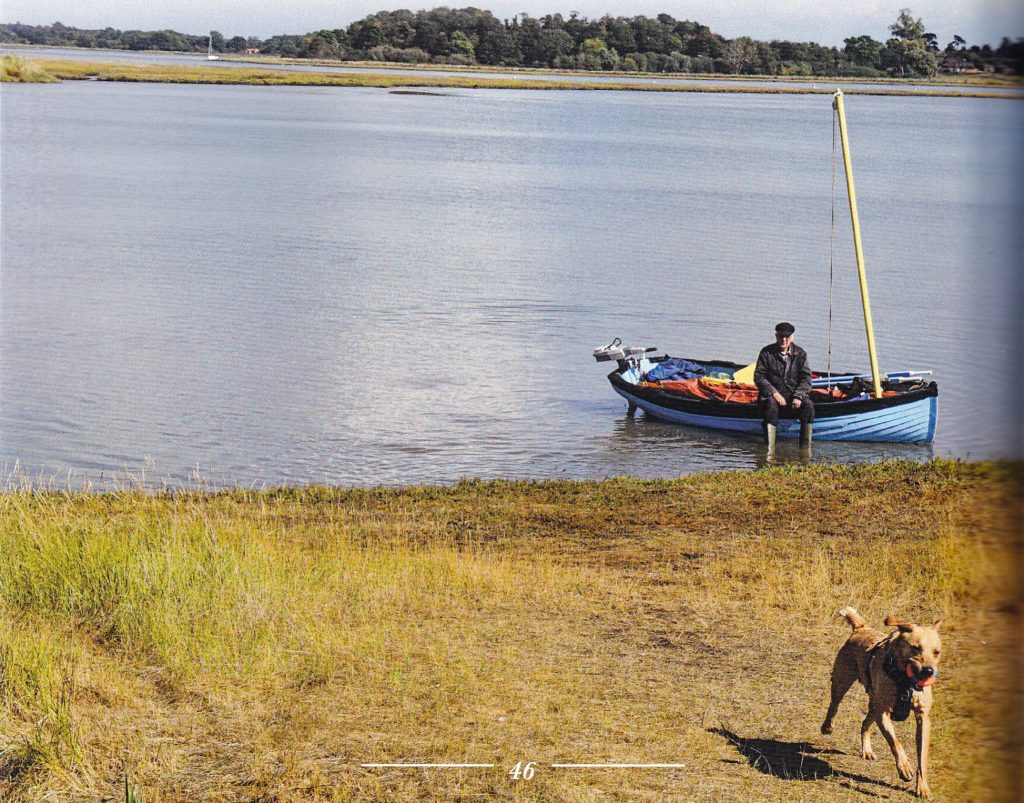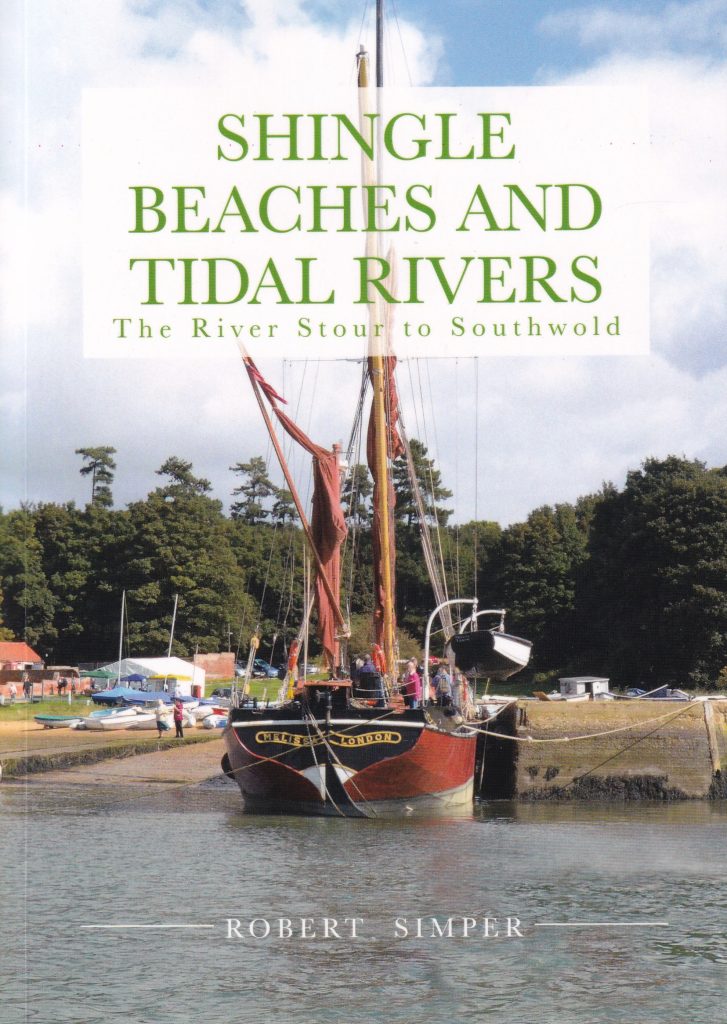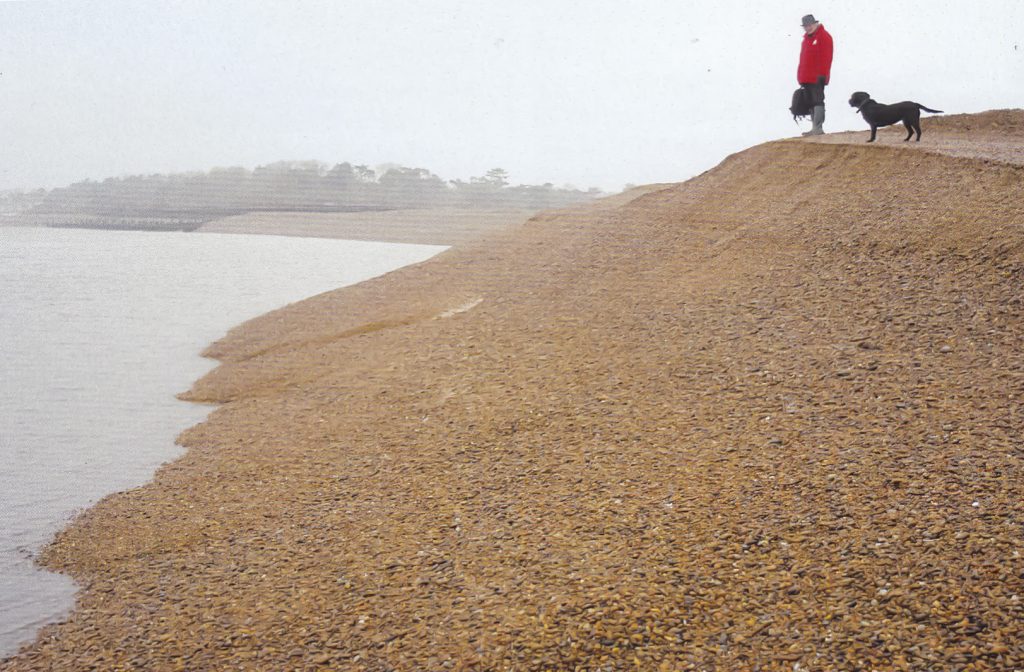A review of Shingle Beaches and Tidal Rivers: the River Stour to Southwold by Robert Simper
Published Creekside Publishing £16.50
By Julia Jones
This is Robert Simper’s farewell to the stretch of Suffolk coast that he has known and loved over more than 80 years. In its introduction he recalls his wartime childhood living at Bawdsey watching bombers coming and going and sometimes aerial dogfights between the RAF and attacking German planes. He was clearly an inquisitive child and one who was shaped by his East Coast environment. ‘The North Sea was in front of us. It looked a cold and unwelcoming place and as time when by I found out it was just that. However, I was fascinated by the rivers and places beside the sea and felt I had to explore them.’
As he grew up, he didn’t just explore what was immediately in front of him – the boats, the places, the people – but looked back in history, learned from others and made connections. He was a farmer and a sailor who learned to write – even if one of his mentors was the somewhat notorious James Wentworth Day who could ’make a muddy creek sound interesting’ but ‘didn’t ruin a good story with hard facts’. His article for this Journal An Accidental Writer (9.7.2021) describes his adventurousness as a self-taught journalist, author, photographer, publisher, He was ready to accept challenges: ‘I once wrote a piece about climbing the Matterhorn, researched on a winter Saturday afternoon in Ipswich Library. I have always hoped nobody got injured or worse after reading it.’ At the heart of his work, however, is his interest in coastal communities, particularly those of Suffolk and Essex – and above all the Deben.

The author pushing his first boat Swallow down the mud beside Ramsholt Dock hard – 1953
I imagine that many people, reading this piece, will already have a collection of Robert’s books on their shelves. They will wonder whether they want another? What does this volume say that’s different?
Shingle Beaches and Tidal Rivers focusses on the area Harwich and the River Stour. northwards to Southwold; ‘where I have been happiest and have most memories’. It’s by no means a comprehensive survey of the area – that has already been built up though his other books. There are entries here for all the main places on the five rivers – the Stour, the Orwell, the Deben, the Ore and Alde, the Blythe — but there’s a slight randomness about the choice of material. Partly this may be due to the patchy nature of memory. Robert wishes he had written down absolutely everything he has learned about the past, ‘I thought I would remember it all, but I didn’t.’ An impossibility, of course.
Instead, what we are given in this volume are the particular facts and details that have sprung to Robert’s mind at the moment he is preparing to leave. These are naturally determined by his individual interests – such as his passion for traditional vessels. There’s a revealing little comment from his early youth when his friends suggest they should cycle down to Dooley Fort (near the former Felixstowe Dock, now vanished under the Port of Felixstowe) and watch the Sunderland airplanes taking off and landing’ I never told them I was more interested in the sailing barge going past.’

The 22ft Great Yarmouth shrimper Crangon entering Southwold Harbour in a strong wind 1997. The author and his son Jonathan fight the tiller to keep her going into the Southwold Harbour.
Any coastal or river community where there has been a boat-building enterprise or where some unique type of craft has been developed, instantly sparks his interest. At Manningtree, for instance, we hear of the racing punts, which were said to have been burned rather than sold by their owners to stop outsiders getting to know their designs. He always relates designs to context and purpose so immediately understands the exaggerated bow shape of Anglo-Saxon replica Sae Wylfing ‘an oar and sail boat, designed to land on open beaches with a long overhanging bow, just right for the crew to jump over the side and haul her up’.
Sometimes, thinking of a place will recall a particular visit – fighting his way into Southwold Harbour with his son Jonathan in a Great Yarmouth shrimper, with a sluicing ebb trying to push them onto the North Pier — or a conversation, such meeting an old bargeman in Holbrook Creek and being enabled to see through his eyes the specific small trading vessels that had visited that spot. Robert is always interested in local communities, their changes and their quirks – he evokes the terrible poverty experienced in c19th Aldeburgh, which feels unimaginable today and reminds us of forgotten communities such as the ‘beach village’ of fishermen’s shacks, swept away by the building of the Wentworth hotel.

The author in his barge boat Atlas in Kirton Creek. Because it has silted up this creek has few visitors by water now. The dog is running up the old Kirton dock for barges.
Sometimes it is callous landlords or rapacious property developers that obliterate communities, more often it is the marauding sea. He considers the hamlet of Slaughden for instance, where the last house went into the sea in 1924. The sea takes farming land as well. Robert resents and is angered by this, particularly when he believes it to be avoidable. ‘The North Sea is quite big enough already.’ His chapter on the Deben – naturally the most varied and interesting in the book – includes passionate refutation of any suggestion that catastrophic damage from a tidal surge – reaching as far as the potential inundation of Woodbridge — can be mitigated by allowing the marshes to flood, including arable land. He is firmly on the side of the Dutch solution – build the river walls higher and stronger.
Robert has a real feeling for the flow of the tide and what this means for places ‘On the upper River Stour Mistley got the trade and Manningtree most of the silt’ largely because of the way the tide swirls around a point and keeps the main Mistley channel deep. His descriptions of the shingle beaches of the book’s title reveal not just his understanding of their shiftiness but also his historical knowledge of the way human intervention has depleted them: the lorryloads of shingle removed from Shingle Street to build runways for American aircraft, for instance. This later had to be replaced by shingle brought from Landguard point, to prevent the Coastguard Cottages falling into the sea. I hadn’t known that the reason the steam dredger, the Holman Sutcliffe – aka Lady Alice Kenlis – ended her days on the Deben was because in 1928 she was being used to dredge the Deben Bar and take the shingle to Harwich to reinforce Parkston Quay.
The shingle ‘knolls’ at the entrance of the Deben, and the Ore and Blyth, are moved around all the time, but mostly in the winter gales. The single is always on the move so that entrance channels change all the time.
This is an individualistic, even quirky book that is full of unexpected insights and observations from a lifetime spent interacting with our local environment, talking to older people, asking questions and thinking about the answers. The final sentences are a passionate plea for positive action against erosion. Shingle Beaches and Tidal Rivers is superficially marred by a large number of spelling and typing errors which I would guess are due not only to the upheaval of moving from Ramsholt to Saltash in Cornwall, but also to the absence of Pearl Simper’s practical help with typing. We are the poorer for her departure as well as Robert’s.
Otherwise, this book is beautifully produced to the usual high standards of the Lavenham Press and the choice and presentation of the photos is a delight. It’s available from Bittern Books bitternbooks.co.uk at £16.50 (ISBN 9781913415952) or possibly to order via bookshops. Remembering how quickly Robert’s Lost Village of Ramsholt sold out, I would urge readers to buy their copy soon. Bittern Books also have the remaining copies from Robert’s back list – another dwindling resource.
Julia Jones


